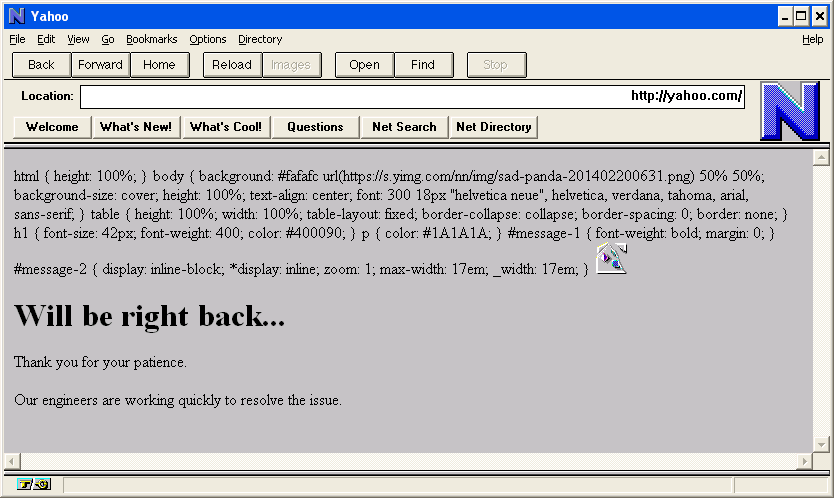20 Years Since Netscape Navigator 1.0

 Twenty years ago today, Netscape Communications Corporation released version 1.0 of Navigator, the browser that became synonymous with the web (for the general public). Well, really the general public (and most developers) referred to the browser as Netscape, not by its real name, Navigator.
Twenty years ago today, Netscape Communications Corporation released version 1.0 of Navigator, the browser that became synonymous with the web (for the general public). Well, really the general public (and most developers) referred to the browser as Netscape, not by its real name, Navigator.
 Based on Mosaic, Navigator quickly replaced the now not-so-cool Mosaic on my work and personal computer, and made Lynx look downright boring. It also presented the world with the creepy pulsing N, which was thankfully replaced pretty quickly. The first release also provided us with the familiar broken image icon that would persist until Internet Explorer’s ubiquity usurped it.
Based on Mosaic, Navigator quickly replaced the now not-so-cool Mosaic on my work and personal computer, and made Lynx look downright boring. It also presented the world with the creepy pulsing N, which was thankfully replaced pretty quickly. The first release also provided us with the familiar broken image icon that would persist until Internet Explorer’s ubiquity usurped it.
Navigator persisted for more than thirteen years after that release, through the ups and downs of the oddly-named browser wars, until it was finally scuttled by its last owner, AOL, on December 28, 2007. AOL released security updates until March 1, 2008, marking the last update Navigator would ever see.
In honor of the browser where I cut my teeth learning all about the web, I grabbed the Navigator 1.0 release from the evolt.org browser archive (Mac and Windows 16-bit only, sorry, and it’s the 1.0N release) and installed it on a shaky WindowsXP virtual machine. Unsurprisingly, trying to surf anywhere with it was a mess. The browser pre-dated frames, cookies, HTML tables (support came in 1.1), JavaScript, and support for any of the robust features of HTTP.


Interestingly, Navigator was first released as free software, only to walk it back a couple months later. The Wikipedia post spends a couple sentences on this:
Netscape announced in its first press release (13 October 1994) that it would make Navigator available without charge to all non-commercial users, and beta versions of version 1.0 and 1.1 were indeed freely downloadable in November 1994 and March 1995, with the full version 1.0 available in December 1994. Netscape’s initial corporate policy regarding Navigator is interesting, as it claimed that it would make Navigator freely available for non-commercial use in accordance with the notion that Internet software should be distributed for free.
However, within 2 months of that press release, Netscape apparently reversed its policy on who could freely obtain and use version 1.0 by only mentioning that educational and non-profit institutions could use version 1.0 at no charge.
If the history of browser is something you find interesting, Wikipedia has this handy timeline of web browsers dating back to 1990. On the plus side, this is an SVG file, so you can zoom in to read it. Eric Meyer has a more structured browser timeline, but it doesn’t start until 1996.

Interestingly, I don’t use Netscape Navigator (any release) at all anymore, but I do still fire up Lynx a few times a month.
Update: August 9, 2015
Quartz has a piece today timed to coincide with the twenty year anniversary of Netscape Communications going public.
It’s sometimes hard to remember that Netscape wasn’t the browser, it was the company. Navigator was the browser.
Don’t scroll too far at the end of the article. The site has annoying advance-to-next-article trickery that kills your back button in order to keep its bounce rate low. For vanity.
Leave a Comment or Response